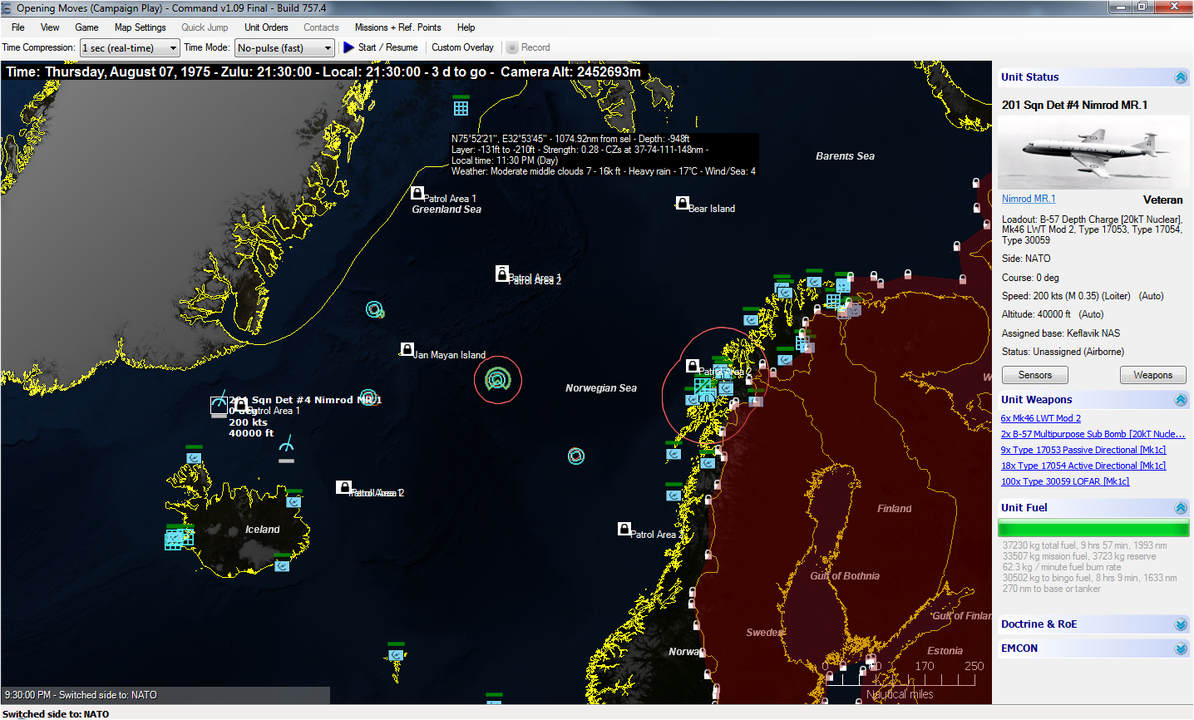For many, all that really needs saying is that Command: Northern Inferno is published by Matrix Games, aficionados and experts in the field of classic wargaming. Where Paradox is mainly known for sweeping strategic games on grandiose levels (like Hearts of Iron), Matrix has spent decades supporting games with a more specific focus (like Panzer Corps and Thirty Years' War). In that department, Matrix has a strong record of excellence.
Developed by Warfare Sims, Northern Inferno is a standalone campaign using their Command: Modern Air/Naval Operations engine, hypothesizing an all-out war between NATO and the Soviet-backed Warsaw Pact starting in August 1975.
THE SITCH
Mirroring one of many Cold War incidents, a Royal Navy frigate has been sunk while shadowing a Russian submarine. As Downing Street and the Kremlin trade accusations, NATO and the Warsaw Pact raise their military alert status. Europe is a powder keg waiting to explode.
In 1975, it was widely believed that a nuclear war was winnable, assuming you could get your strikes in before the enemy could launch most (or better yet, any) of their own. Inter-Continental Ballistic Missiles (ICBMs) could theoretically be intercepted, but neither NATO nor the Soviets had a substantial capability to do so. Nonetheless, observation satellites ensured any large-scale ICBM launches would be detected in time to allow a massive counter-strike. Bombers were highly detectable, and much more susceptible to being intercepted.
Submarine-Launched Ballistic Missiles, though... if you could sneak a few dozen subs into position off an enemy's shores, each bearing as many as sixteen nukes, "first-strike capability" might be a reality. With ten minutes or less from launch to impact, an enemy would barely have enough time to get their President or Premier on the phone, before bomber and missile bases started having their teeth pulled in the most violent fashion yet devised by humanity. Which is why it's such a big deal that a Soviet sub has just sunk the British ship keeping tabs on it. Neither side is tolerant of opposing nuclear submarines roaming the world's oceans undetected.
As a NATO naval theater commander with the Cold War going Hot, that's the strategic situation you'll face in Northern Inferno. It's a giant game of cat-and-mouse, in the best spirit of Tom Clancy's Red October. Only instead of a rogue captain with a new super-sub creating an international incident, whole fleets are deploying for an epic face-off right from the start.

"RTFM"
That sounds really interesting, but be warned. As with many Matrix games, your first step is to heed the Ancient Gamer's Creed: read the freakin' manual. The game's design assumes you already know what you're doing, meaning Northern Inferno will mainly appeal to those who already enjoy the original game, or who otherwise appreciate having to spend their first couple of hours reading instead of playing. Or, you could be lazy and click "Help" for access to video tutorials.
Most gamers (like me) will probably just shout "YOLO!" and click "Campaign" instead.
As a word of warning, there isn't any volume control. You can turn sounds on or off, and that's it, with actual volume only controllable from your PC's sound panel. If you don't do that, you're going to want to play with headphones off and set to one side, unless you like mopping what's left of your eardrums off the desk. You'll also probably get sick of the in-game music after the first hour or so.
Despite these minor drawbacks, Northern Inferno has a lot going for it, especially in the detail department. I almost want to get a giant wall-mounted TV and play it on that while smoking a Cuban cigar, so as to get the full "War Games" feel going.

The basic interface is pretty simple: arrow keys move the map around, while mousewheel zooms in and out. Although you can see the entire globe, the only points of interest are within your assigned theater of command. Where your mouse arrow touches, you get a complete up-to-date weather report for that area. Clicking a unit's symbol will surround it with a white box (see the left-center there), bringing up its basic information (shown on the right).
This is where things hit an extremely high learning curve. Right-clicking the unit accesses a dizzying array of possible orders you can give it, from setting patrol patterns to setting formations to laying sonobuoys to dropping 20-kiloton nuclear depth charges. You can even use the "Doctrine & RoE" dropdown to change preset orders... in other words, how that unit's AI will avoid, start, prosecute, or end a fight under various circumstances. "EMCON" (EMissions CONtrol) lets you order radio silence and try your hand at being sneaky-beaky. Much of this has no context for the ignorant: what, for example, does it mean to "Deploy Dipping Sonar"? RTFM, my friends.

Everything is covered. Every radar station, airbase, seabed listening array, ship, sub and aircraft in the theater of operations, each with their own detection and weapons systems. Even the "Mark I Eyeball", without a hint of japery, is included as a sensor with its own set of stats and abilities.
This shows that pure player agency is where the Command: Modern Air/Naval Operations engine truly shines. Aside from your assigned area of operations and your orders, there are no rails here, no handholds, no meaningless choices. How well you use the assets at your disposal, versus how well the AI uses theirs, that alone will determine the outcome.
Good luck, Commander.
Command: Northern Inferno is available on Steam and from Matrix Games. The game was played, using a review code from Warfare Sims, on the PC platform.
Review Summary
A polished, in-depth wargame, held back by a learning curve which approaches the severity of a right-angle. Those familiar with naval warfare technology of the 1970s will feel right at home, everyone else will have a lot of reading and video tutorials ahead of them.
(Review Policy)Have a tip, or want to point out something we missed? Leave a Comment or e-mail us at tips@techraptor.net












